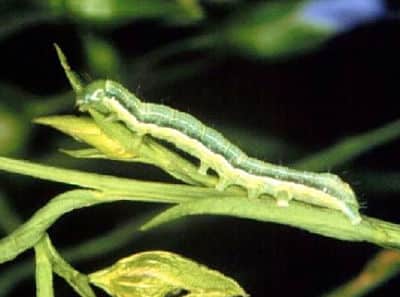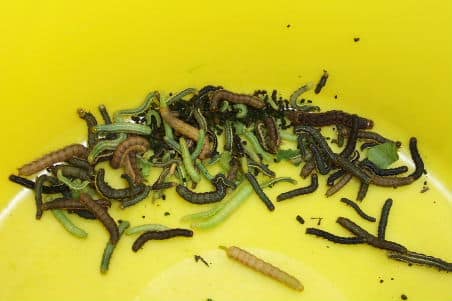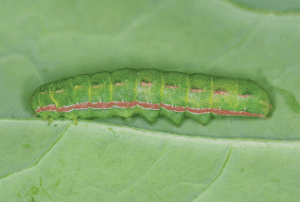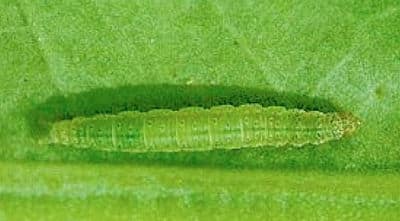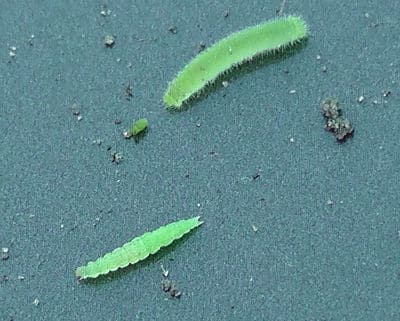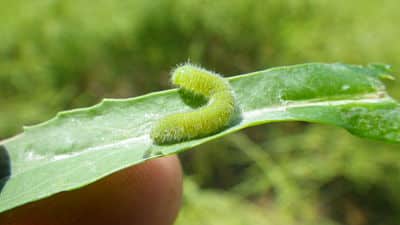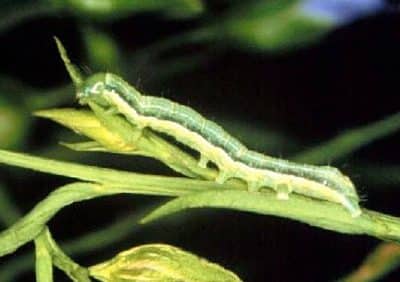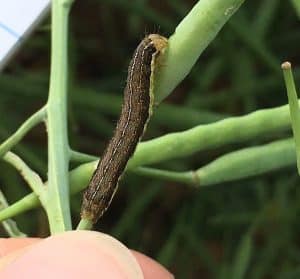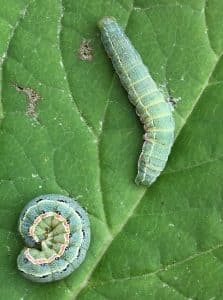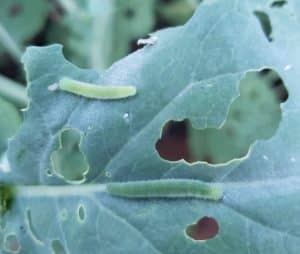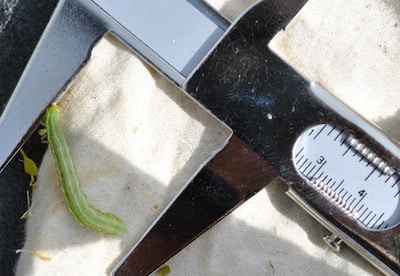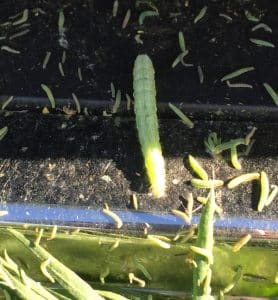Before spraying, make sure your canola is at the right stage to be damaged by the worms and that the worms are actually the species you’re trying to control. Here’s how to distinguish the five most common green worms in canola. (Photos at the bottom.)
Bertha armyworm
Berthas come in brown, black and green shades. The green berthas are shinier than other green worms, and the yellow-orange stripe along each side is more pronounced, even on younger ones. Mature larvae are up to 1.5” long, making them considerably larger than diamondback moth larvae at late stages. Being part of the cutworm family, they also curl up when agitated. While cabbageworms tend to stay on the leaves as long as leaves are available, bertha will move up into the pods earlier. Find results for adult (moth) traps here: Alberta map and details on the risk levels. See Saskatchewan’s bertha info and downloadable map. Read the Canola Encyclopedia for more on scouting and thresholds.
Clover cutworm
Clover cutworm is easy to confuse with bertha armyworm. They are about the same size when mature (1” to 1.5”). They can both be green or brown, even black. They both have stripes down the side. The key differences are that the clover cutworm stripe is pink and the bertha stripe is yellow or orange, and that clover cutworms cycle earlier. Clover cutworms can be large in June and mature by mid July, while bertha armyworm are usually tiny in mid July, if present at all. Manitoba Agriculture’s provincial entomologist John Gavloski says that in rare cases, clover cutworms can cause economic levels of damage in areas within a canola field. But in most instances, levels are lower and spraying is not usually worth considering. Read more.
Diamondback moth larvae
When agitated, diamondback moth larvae will wiggle backwards and dangle from the plant on a thread. Diamondback moth larvae are spindle shaped – fatter in the middle than at the end. They also rarely grow beyond 12 mm (0.5”) in length, versus bertha larvae which can reach 4 cm (1.5”). The threshold for diamondback larvae is about 200 per square metre. Read more.
Imported cabbageworm (larvae of cabbage butterfly)
These worms are light green with a lemon-yellow stripe down the middle of the back (dorsal side). They are covered with short hairs giving it a velvety appearance. They grow to about 30 mm. Cabbageworms look more like diamondback moth larvae than bertha armyworms, but are more docile than diamondback moth larvae and less spindle shaped. As long as there is good vegetative growth, they feed mostly on leaves and it is not usually economical to spray them. Some growers have reported 8-10 per plant, but before spraying, check regularly to see if damage ceases over the next week. Cabbageworms have 2-3 generations per year and will go into pupal stage quicker than the other two larvae. Most cabbageworms in southern Alberta are infested with parasitoids, so they feed less and die before pupating. Read more.
Alfalfa looper
Alfalfa looper (Autographia californica) can be confused with bertha armyworm. The looper has white stripes down the sides and back, while bertha armyworm will have a yellow/orange stripe along each side. Alfalfa looper “loops” when it crawls, while bertha armyworm does not. They also differ in the number of prolegs. Alfalfa looper only has two pairs of mid-abdominal prolegs and one pair at the back, while bertha armyworm has four pairs of prolegs in the middle of the abdomen and one pair at the back of the abdomen. Loopers are 24 mm long (1”) with light green or olive colour, and a paler head than berthas. Mature larvae have a swollen abdomen. There is no economic threshold available as this is not as common a pest in canola. Delaying insecticide application as long as possible may allow viral diseases to reduce populations.
Another lookalike is the cabbage looper (Trichoplusia ni), which Jim Tansey, insect specialist with Saskatchewan Ministry of Agriculture, has been found in canola.
Distinguishing these loopers from bertha armyworm may not be required. John Gavloski, entomologist with Manitoba Agriculture, provides this insight: “No thresholds have been developed for alfalfa looper in canola, but the recommendation in our WCCP Guide to Integrated Control of Insect Pests of Crops is to use thresholds for bertha armyworms as a guideline. Given the lack of research, if larvae of both insects were present in a field it would make sense to count both and compare the cumulative count of both to the bertha armyworm threshold.” Read more.
Scout throughout each field. Insects may be concentrated only in certain areas in the field, while the rest of the field is not seriously affected. A blanket spray of the whole field may not be warranted. Larval numbers can also vary substantially between fields in close proximity, depending on crop staging and the attractiveness of the field at egg laying.
